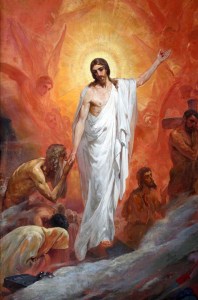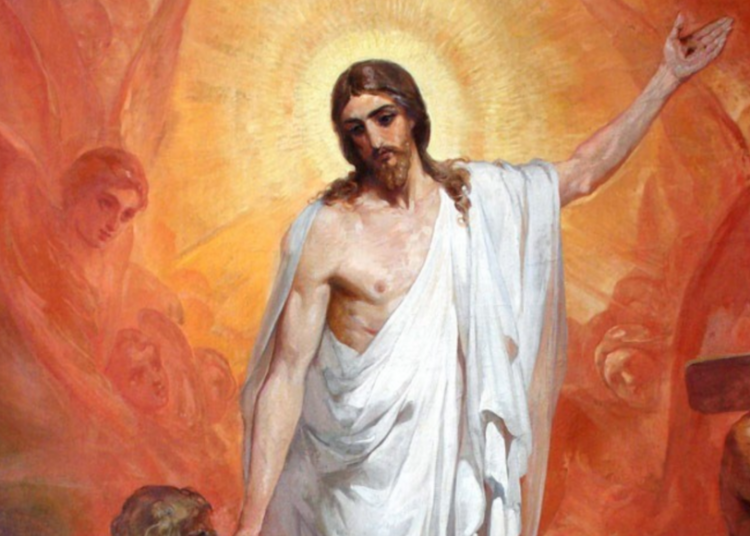Christ descended into hell to deliver His loved ones from their exile. He came to reward those who, from our first father, Adam, to His own foster-father, St. Joseph, had fought the good fight and had finished the race.
 The second reading from the Office of Readings for Holy Saturday is taken from an ancient homily on Christ’s descent into hell. It begins: “Something strange is happening—there is a great silence on earth today, a great silence and stillness. The whole earth keeps silence because the King is asleep.” The King fell asleep when His soul was separated from His body on Good Friday afternoon. He remained asleep until His soul reanimated His body on Easter morning. But during the silence and stillness of the King’s sleep, He harrowed hell.
The second reading from the Office of Readings for Holy Saturday is taken from an ancient homily on Christ’s descent into hell. It begins: “Something strange is happening—there is a great silence on earth today, a great silence and stillness. The whole earth keeps silence because the King is asleep.” The King fell asleep when His soul was separated from His body on Good Friday afternoon. He remained asleep until His soul reanimated His body on Easter morning. But during the silence and stillness of the King’s sleep, He harrowed hell.
Our Lord’s descent into hell is well attested to by divine revelation. For example, Christ says, “as Jonah was three days and three nights in the belly of a whale, so will the Son of man be three days and three nights in the belly of the earth” (Mt. 12:40). Further, in Acts of the Apostles, St. Peter says, “[David] foresaw and spoke of the resurrection of the Christ, that he was not abandoned to Hades, nor did his flesh see corruption” (2:31). Likewise in the Apostles’ Creed we profess, “He descended into hell.”
Besides making clear that the soul of Christ descended into hell, these texts clearly refer the descent into hell to the Person of Christ. And this is supremely fitting. For, since the personal union of the Word of God with both His body and soul remained even after death, whatever could be attributed to either of these principles of His human nature, while they were separated, was also attributable to God the Son. Thus, in the Apostles’ Creed we profess that He (i.e., God the Son) was buried insofar as His body was placed in the tomb. In like manner, we profess that God the Son descended into hell on account of His soul going to the underworld.
Connected with this, St. Thomas Aquinas points out that it is even true to say that “during the three days of His death, the whole Christ was in the tomb, in hell, and in heaven, on account of His Person, which was united to His body lying in the tomb, and to His soul-harrowing hell, and which was subsisting in His divine nature reigning in heaven” (Compendium Theologiae, ch. 229). Indeed, insofar as by His divine immensity the Son of God comprehends or contains all things, we must affirm that the whole Person of Christ is both in every place and in all places put together, yet He is not wholly contained by any one place nor by all places put together (Summa Theologiae, III, q 52, a. 3, ad 3um).
When reflecting on our Lord’s harrowing of hell, it is, of course, necessary to distinguish different meanings of the name “hell.” In its most general meaning, “hell” signifies “the underworld,” which the Hebrews refer to as, Sheol, and the Greeks call by the name, Hades (Catechism of the Catholic Church, #633). Further, as the Roman Catechism teaches, there are three main parts to the underworld. There is gehenna, or hell in the strict sense, which is the abode of the damned. There is also purgatory wherein the punishments, unlike those of gehenna, are cleansing and only temporary in character. Lastly, there is that part of the underworld known as “Abraham’s bosom” (see, Luke 16:22-26). It was in here that “the souls of the just prior to the coming of Christ the Lord were received, and where, without experiencing any sort of pain, but supported by the blessed hope of redemption, they enjoyed peaceful repose” (Roman Catechism, pt. 1, art. 5).
So, into which part or parts of hell did Christ descend and why? Taking St. Thomas Aquinas as our guide, we can affirm both that our Lord descended into all three parts of hell and that He descended into only one part of hell (i.e., into Abraham’s bosom). But to see how both of these statements are true without contradiction, we must distinguish two ways in which something can be somewhere.
Thinking of everyday examples first, it is true that one and the same fire is simultaneously both in the fireplace and in every part of the room which it heats. The fire is in the fireplace as in a proper place, while it is in every part of the room through its effect, that is, through the heat which it produces. Likewise, it is true that one and the same musician is simultaneously both on the stage and in every part of the concert hall. For the musician is on the stage insofar as that is his proper place, yet he is also present in every part of the concert hall through his effect, that is, through the music that he produces.
Applying this distinction to our Lord’s descent into hell, it is true to say that Christ’s soul, through its essence, only entered Abraham’s bosom. Nonetheless, through its effect, Christ’s soul was in some way present in every part of hell. As St. Thomas puts it, “being in one part of hell, his effect in some way spread to every part of hell, just as by suffering in one place on earth, he liberated the whole world by His passion” (Summa Theologiae, III, q. 52, a. 2). More specifically, St. Thomas teaches that the proper effect of Christ in the underworld was the bestowal of the beatific vision on the souls of the just waiting for Him in Abraham’s bosom. This, properly speaking, constitutes the harrowing or despoiling of hell. For, through granting the souls of the just the vision which beatifies, the King of all things “robbed” hell of its most prized possessions. But Christ’s presence in hell also had the effects of giving hope of attaining eternal glory to the souls in purgatory and of confounding and bewildering those in gehenna (Summa Theologiae, III, q. 52, a. 2).
These considerations, in turn, cast some light on the reasons for God the Son’s descent into hell. For one thing, He went there to manifest His power and authority to the underworld. As St. Paul writes, “at Jesus’ name every knee must bend in the heavens, on the earth, and under the earth, and every tongue proclaim to the glory of God the Father: Jesus Christ in Lord!” (Phil. 2:10-11). But secondly, and more importantly, our Lord came to deliver His loved ones from their exile. He came to reward those who, from our first father, Adam, to His own foster-father, St. Joseph, had fought the good fight and had finished the race. The King descended into Hell in order to bring nothing less than His own beatific vision, the very paradise which He promised to Dismas just a few hours before (Lk. 23:43), to these just and holy souls.
It is most fitting, then, that the aforementioned homily contains these beautiful words spoken by Christ to our first father, Adam:
Out of love for you and for your descendants I now by my own authority command all who are held in bondage to come forth, all who are in darkness to be enlightened, all who are sleeping to arise. I order you, O sleeper, to awake. I did not create you to be held a prisoner in hell. Rise from the dead, for I am the life of the dead. Rise up, work of my hands, you who were created in my image. Rise, let us leave this place, for you are in me and I am in you; together we form only one person and we cannot be separated.
During the silence and stillness of the King’s sleep, He harrowed hell. During the King’s sleep alleluias sounded in hell in anticipation of those that would sound here above on the morning of the third day.
Republished with gracious permission from Crisis Magazine (2014).
This essay was first published here in April 2021.
The Imaginative Conservative applies the principle of appreciation to the discussion of culture and politics—we approach dialogue with magnanimity rather than with mere civility. Will you help us remain a refreshing oasis in the increasingly contentious arena of modern discourse? Please consider donating now.
The featured image is “Harrowing of Hell” (1900) by Nikolay Koshelev and in the public domain, courtesy of Wikimedia Commons.


